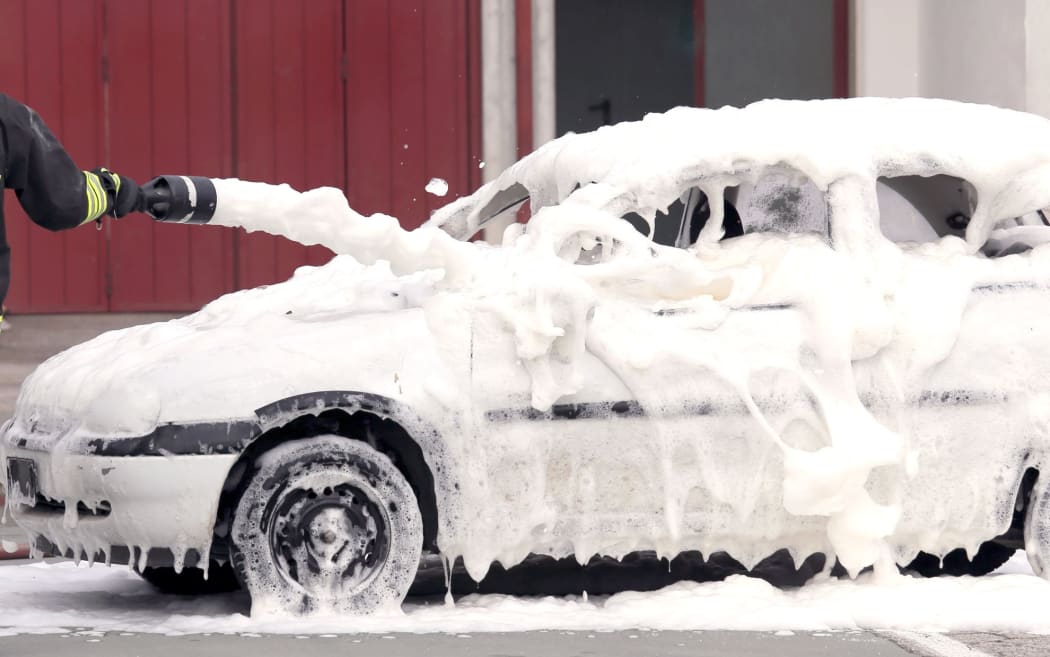A study that US officials fought to hold back has been released, showing current levels set for firefighting foam chemicals in water, both in the US and New Zealand, may be way too high.

Firefighting foam (file photo) Photo: 123RF
The Trump Administration had dubbed the draft report from the US Centers for Disease Control a "public relations nightmare", but was forced to release it yesterday.
It says the chemicals, in a group called perfluoroalkyls or PFASs, could be a threat to human health at levels seven to 10 times lower than the current guidelines.
Like the US, New Zealand is investigating mass contamination from firefighting foam residue in water supplies, as is Australia.
The draft report suggested new safe levels in drinking water of seven parts per trillion (ppt) for the chemical PFOS and 11 ppt for PFOA.
New Zealand guidelines are 70ppt for PFOS and 560ppt for PFOA.
"Oh my goodness, that is way too high," said New Hampshire state lawmaker Mindi Messmer, an enviromental scientist of three decades who's now running for Congress on a clean-water platform.
"Certainly if the 560 is current, that is certainly troubling."
The European Union classifies PFOA as suspected of causing cancer, and that it may damage fertility and unborn children, and damage organs through long or repeated exposure.
New Zealand should lower its levels quickly, Ms Messmer said.
"I hope that happens really soon, if I was a legislator there I would be very much aggressively fighting for that."
On the same day the CDC report was released, the New York Attorney-General Barbara Underwood launched what she called "landmark" legal action against five manufacturers of PFASs, including 3M.
She successfully ran for the New Hampshire state legislature in 2016 after working since 2014 in a taskforce investigating a cluster of child cancer cases that firefighting chemicals were linked to.
Her first Bill after her election was to lower PFAS threshold levels in water from an EPA-approved 400 parts per trillion for PFOA and half that for PFOS, down to 70 for both. But she said she faced stiff opposition.
"That was heavily fought by the regulators, municipal associations, and business and industry associations, and the manufacturers."
The levels were subsequently lowered both by the state, and EPA, but not low enough, she said, and so she put through another Bill, that had just won through, to drop the levels further to 20 parts per trillion for both chemicals.
"One of the most important things is to not yield to industry influence. What we saw here was a lot of industry pushback because they realised they were responsible for contaminating.
"You know, they told our Defence Department here it was basically soapsuds, that there was no health effects. And now we've found out ... that as far back as 1974 the manufacturers knew fully that this caused health problems. So that's been hidden from the public since 1974."
Both PFOS and PFOA have been banned in firefighting foam in New Zealand since 2006, though some airports still stock them, and because they are so longlasting, they will remain in the water for centuries.
Current foam still contains many PFASs, usually of types that have six rather than eight-chain compounds, so it's smaller.
"The jury is still out on the safety of those," Ms Messmer said. "They're actually more costly to remove, early indications of that, and there are some early health studies that I've seen that because of the smaller size of the molecules they may actually reside in the organs rather than be excreted."
Ms Messmer's new legislation added two other PFASs to the regulations, PFNA and PFHxS.
Water testing in New Zealand has included tests for PFHxS. But neither it or PFNA, or other PFASs, are banned or regulated.
"It will be a nasty wake-up call if New Zealand do it badly or wrongly as it will be very costly to backtrack to fix things," said Adjunct Professor at Murdoch University in Perth and environmental consultant, Jimmy Seow.
"I keep telling people ... time is your enemy and time cost lots of money," said Dr Seow.
Over time, PFASs in foam moved easily into water, and over time compounds in them broke down into PFOA, "hence double whammy", he said.



